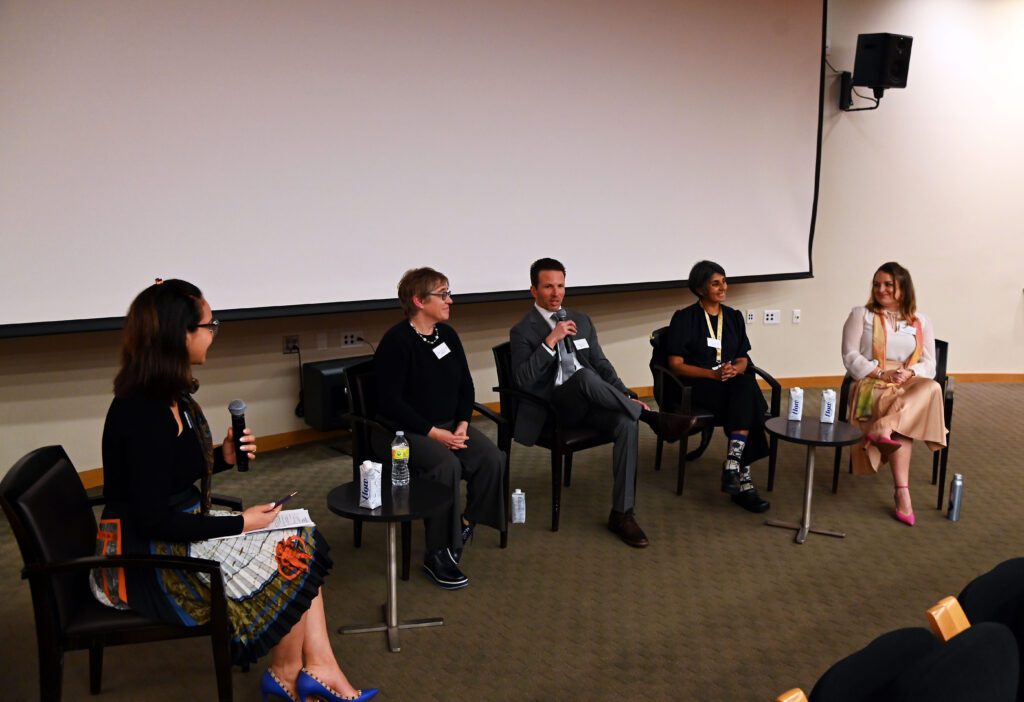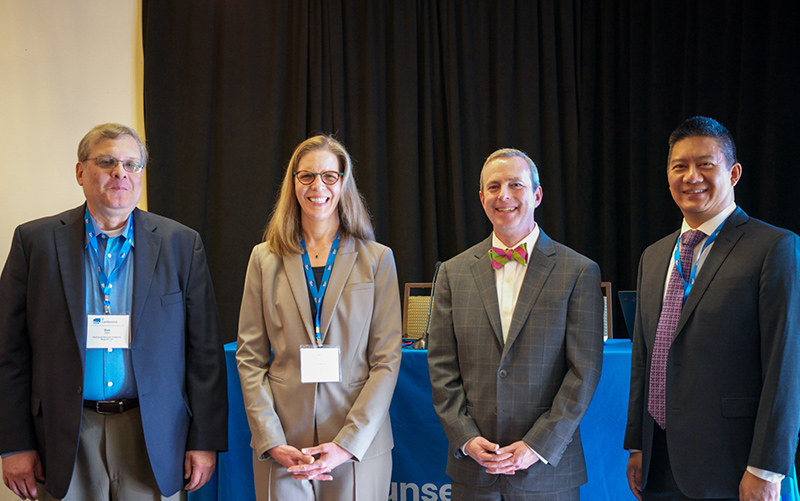“If you want to go fast, go alone,” said Interim Dean of UCLA’s Division of Social Sciences, Abel Valenzuela Jr., giving opening remarks at an event, When Medicine Stops Saving Us: The Antimicrobial Resistance Crisis on January 22. “If you want to go far, go together.”
UCLA partnered with the Biotechnology Innovation Organization (BIO), Turn Therapeutics, and the Infectious Disease Society of America to discuss how we can work together to find solutions to the growing threat of antimicrobial resistance (AMR).
“We approach problems holistically,” continued Dean Valenzuela. “We believe that true advancements are made and big solutions are achieved by involving and working with experts and leaders across multiple disciplines who are all tackling the same issue from their unique areas of expertise.”
The panel went on to discuss, among other topics, AMR’s branding problem, the threat associated with the improper use of antimicrobials, and the potential of legislation like the PASTEUR Act to help solve critical AMR-related challenges.
AMR’s branding problem
“It’s going to sound simplistic,” began Bradley Burnam, founder and CEO of Turn Therapeutics, “but I actually think AMR has a branding problem.”
“My mom was married to a cardiologist for 32 years, and was mother to a son who went through a drug-resistant infection,” the AMR-survivor-turned-biotech-founder explained. “When I asked her a few months ago, ‘What does AMR stand for?‘ she didn’t know.”
“We need to be a little bit better about telling the history of antibiotics and antimicrobial resistance,” echoed Hannah Landecker, Ph.D., Professor, UCLA Department of Sociology.
“At the same time as we were thinking about antibiotics as a magic bullet,” Landecker continued, “and their wonderful properties, we were losing sight of bacteria phages [viruses that infect bacteria], as a potential thing to also harness and use in this way as something that humans could perhaps use to live with bacteria.”
“Antibiotics are not just an innovation that has been completed. Their development is still very much with us. So, we need to learn from the history of innovation, and we need to integrate these lessons into the stories we tell.”
Unlike other drugs, antimicrobials can have a unique risk when it comes to the ways that they are used. Using antimicrobials inappropriately—including not finishing their full course—can promote the development of antimicrobial-resistant bacteria and fungi. This can cause serious danger for patients on a variety of levels.
The challenge of AMR
“People don’t know that AMR today, in terms of deaths, has superseded HIV and malaria together,” explained Jomana Musmar, MS, Ph.D., Executive Director of the Presidential Advisory Council for Combating Antibiotic-Resistant Bacteria (PACCARB), who moderated the discussion.
“We’ve been over taking antibiotics because we [have] this fear of not getting too sick,” she continued. “But it [is] actually harming us down the line.”
It is counterintuitive to many patients that drugs they have probably been prescribed many times in their lives, and that have been credited as one of the biggest jumps in the history of medical innovation, can have negative effects if not taken properly. And patients may be shocked to find that drug-resistant infections are, frankly, everywhere.
“I think it’s important to recognize that AMR is not just hospital-acquired,” said Tara Vijayan, M.D., Associate Clinical Professor of Infectious Disease and Medical Director of Antimicrobial Stewardship at the UCLA David Geffen School of Medicine. “We’re not just talking about hospital-acquired infections. We’re also talking about sexually transmitted infections. We’re talking about the fact that people don’t have access to health care to treat those sexually transmitted infections. We’re talking about diarrheal illness, and we’re talking about global infections that are actually becoming more and more drug-resistant.”
The potential for the spread of drug-resistant diseases, and the diversity of forms that they can take, is why AMR research advocates are so passionate about researching new types of antimicrobials, as well as ensuring appropriate access to them worldwide and taking a One Health approach.
“When we’re thinking about access. We’re thinking about access to antibiotics, for sure, globally, but we’re also thinking about access to other things,” Vijayan continued “We’re thinking about access to vaccines that can prevent the viral infections that subsequently lead to bacterial infections. We’re talking about access to clean water, where that’s the most common source of diarrheal infections. So, all of these things are intertwined and interpolated and very much part of the One Health paradigm.”
“We don’t have enough infectious disease doctors,” said Vijayan. “We don’t have enough antimicrobial stewards. We don’t have enough antimicrobial pharmacists. These are all sort of really important figures in trying to make sure that antibiotics are actually used appropriately. This is true in the US, where 80% of counties actually don’t have an infectious disease physician, [and this is true] worldwide where most countries actually don’t have an infectious disease workforce.”
There are policy solutions that would help address AMR
Emily Wheeler, Director of Infectious Disease Policy at BIO, connected many of the healthcare, social, and policy dots when it comes to addressing AMR.
But to understand the importance of specific legislation, students, policy professionals, and patients need to understand a little bit about the R&D pipeline.
“It takes on average about 10 years [to develop new drugs and treatments],” explained Wheeler. “And maybe 1 in 10 [companies] make it from starting research and through all of that research and development, companies are needing to raise funds to keep afloat and sustain those clinical trials and get to an FDA approval. There is a time during that research and development process called the ‘Valley of Death,’ where companies often go under, and that’s why we see that only 1 in 10 end up making it, on average.”
When it comes to the “Valley of Death” problem, it is also important to note that “we’ve seen the exodus of large pharmaceutical companies from the antimicrobial market almost entirely over the past 10 years,” explains Wheeler.
“And the innovators that are developing these products, 95% of those are small biotech firms, and over 50% of those are what we call pre-revenue. They have no products on the market and they’re moving forward a lead candidate that can attack some of these superbugs and they’re hoping and working to get that product to the market and available to patients.”
“When a drug is approved, that is often time for celebration,” said Wheeler.
But for now, celebrations must be tempered. “[If an antimicrobial drug company does make it through] and is able to sell it on the marketplace, the volume-based sales model, that works for other areas of medicine, fundamentally does not work, and should not work, for antimicrobials,” continued Wheeler. “We want these innovative products to come to the market and to be available for patients. However, we only want them to be used when they are necessary for the patient.”
Obviously, that’s “a really bad business case,” said Wheeler. “That’s why we need to be approaching [the development and commercialization of antimicrobials] in a fundamentally unique way to ensure that we have the products we need to treat these infections.”
So what needs to happen on the policy level to build a market for the development of these drugs?
Enter: The PASTEUR Act.
The bipartisan, bicameral bill “would create a model that is not tied to volume, but instead is a subscription model,” explained Wheeler. “The US government would enter into contracts with a developer of a new and innovative [antimicrobial] medicine where they can use as much or as little of that new medicine in federal healthcare settings…That then provides a predictable return for the company to continue to invest back into their research and development cycle,but [it would be a model] that is fundamentally rooted in appropriate antimicrobial use. So, there is no incentive to use these products incorrectly or inappropriately, but there is still a way for innovators to recoup some of that costly R&D to get that product to the market and then to go back and continue innovating.”
Currently, the bipartisan, bicameral PASTEUR Act is under consideration in Congress. On the bright side, the presence of a proposal like this signals a shift in both public and political awareness of AMR—a welcome light in the darkness.
Rep. Mike Levin (D-CA), a co-lead of the PASTEUR Act gave remarks at the conclusion of the event to explain some of the policy steps that are being taken to tackle AMR.
“COVID-19 served as a reminder of how important infectious disease research is as we prepare to prevent the next pandemic,” began Rep. Levin. “A study conducted in 2021 found that nearly half of COVID patients with a secondary bacterial infection died, and three in four patients who had more than one bacterial infection died as a result. Unfortunately, the pipeline of novel antimicrobials is dwindling and fewer companies have the capability to invest in research and development to discover new medicines.”
And Congress can help. “We have a lot to do and a long way to go. But with legislative efforts like [the PASTEUR Act], I’m confident Congress will continue to find new ways to address AMR and fund new research and technologies,” said Rep. Levin.
“There is growing recognition in the public, though there still needs to be more,” said Wheeler, “as well as in Congress and in the Administration, about the threat of antimicrobial resistance and the impact of that on our nation and our world. and about the urgent need for action.”




